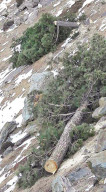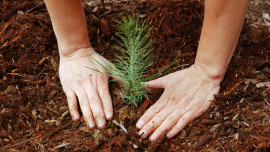
WASHINGTON DC: Granting formal land rights to indigenous people living in the world's tropical forests is among the most effective, but underused, ways to stop illegal deforestation that fuels violence, poverty and global warming, according to new research.
Local communities are best equipped to safeguard valuable forests, and those with strong land rights are the most effective, said a raft of studies presented this week at the World Bank's annual Land and Poverty Conference.
Deforestation is known to be detrimental to the earth's climate.
Clearing woodlands for agriculture and grazing, and fires that often follow, is responsible for about one-tenth of carbon emissions that contribute to a dangerous rise in global temperatures, researchers say.
Shrinking forests can cause poverty and conflicts as well, as local residents are forced to compete for fewer resources.
Deforestation exposes mountain communities to landslides, flash floods
A six-nation study for the World Bank's Programme on Forests found deforestation rates are significantly lower where communities have legal rights to the forests and government support for management and enforcement, compared with areas elsewhere.
"Critical links" exist among land security, local economic development, biodiversity conservation and reduced carbon emissions, it said.
Research from Indonesia showed conflict over land was minimised and investment was encouraged when local communities were involved in designing transportation corridors around proposed mining projects.
Another study from Indonesia showed granting long-term rights over mangrove swamps to indigenous people has better protected the critical coastal ecosystems than in areas where the endangered buffers between land and sea are not locally managed.
Less than a fifth of the world's population has formal land rights, or tenure. More than 1,500 land rights specialists converged on the US capital this week to share their findings.
The use of giant swathes of information such as advanced satellite imagery can identify patterns such as water use in land rights and land management, said Andrew Steer, head of the Washington-based World Resources Institute and a former World Bank Special Envoy for Climate Change.
"We can show water risk, make future projections of population, use crowd sourcing and cloud computing in a way that is transforming how water is used by private companies and indigenous communities," he said.
World Forest Day: Conserve water, trees to mitigate climate change impact
Many papers highlighted challenges posed to developing nations by big mining and agricultural industries that are using technology to gain access to remote regions.
Nevertheless, researchers said indigenous peoples and campaigners working with them are harnessing technology as well to expose illegal deforestation or land use and seek remedies and justice.
The research is significant to help back up indigenous communities' claims that they are the best custodians of global forests. Some critics have claimed remote tropical forests looked after by indigenous groups are protected due to a lack of development pressure rather than good management techniques.
An estimated 15 per cent of the world's forest cover remains untouched.
Brazil, once a leader in slowing deforestation, has recently been accused of rolling back gains made by providing land rights to rural people in the face of recession and a political crisis.
The World Bank estimates that forest ecosystems cover a fifth of the land in Latin America, representing half of the world's tropical forests.


































































COMMENTS
Comments are moderated and generally will be posted if they are on-topic and not abusive.
For more information, please see our Comments FAQ